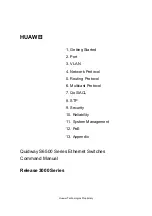
Functional Description
11.3.13 Event Dataflow
This section summarizes the data flow of a single event, from the time the event is latched to the channel
controller to the time the transfer completion code is returned. The following steps list the sequence of
EDMA3CC activity:
1. Event is asserted from an external source (peripheral or external interrupt). This also is similar for a
manually-triggered, chained-triggered, or QDMA-triggered event. The event is latched into the
ER.En/ERH.En (or CER.En/CERH.En, ESR.En /ESRH.En, QER.En) bit.
2. Once an event is prioritized and queued into the appropriate event queue, the SER.En\SERH.En (or
QSER.En) bit is set to inform the event prioritization/processing logic to disregard this event since it is
already in the queue. Alternatively, if the transfer controller and the event queue are empty, then the
event bypasses the queue.
3. The EDMA3CC processing and the submission logic evaluates the appropriate PaRAM set and
determines whether it is a non-null and non-dummy transfer request (TR).
4. The EDMA3CC clears the ER.En/ERH.En (or CER.En/CERH.En, ESR.En/ESRH.En, QER.En) bit and
the SER.En/SERH.En bit as soon as it determines the TR is non-null. In the case of a null set, the
SER.En/SERH.En bit remains set. It submits the non-null/non-dummy TR to the associated transfer
controller. If the TR was programmed for early completion, the EDMA3CC immediately sets the
interrupt pending register (IPR.I[TCC]/IPRH.I[TCC]-32).
5. If the TR was programmed for normal completion, the EDMA3CC sets the interrupt pending register
(IPR.I[TCC]/IPRH.I[TCC]) when the EDMA3TC informs the EDMA3CC about completion of the transfer
(returns transfer completion codes).
6. The EDMA3CC programs the associated EDMA3TCn's Program Register Set with the TR.
7. The TR is then passed to the Source Active set and the DST FIFO Register Set, if both the register
sets are available.
8. The Read Controller processes the TR by issuing read commands to the source slave endpoint. The
Read Data lands in the Data FIFO of the EDMA3TCn.
9. As soon as sufficient data is available, the Write Controller begins processing the TR by issuing write
commands to the destination slave endpoint.
10. This continues until the TR completes and the EDMA3TCn then signals completion status to the
EDMA3CC.
11.3.14 EDMA3 Prioritization
The EDMA3 controller has many implementation rules to deal with concurrent events/channels, transfers,
etc. The following subsections detail various arbitration details whenever there might be occurrence of
concurrent activity.
shows the different places EDMA3 priorities come into play.
11.3.14.1 Channel Priority
The DMA event registers (ER and ERH) capture up to 64 events; likewise, the QDMA event register
(QER) captures QDMA events for all QDMA channels; therefore, it is possible for events to occur
simultaneously on the DMA/QDMA event inputs. For events arriving simultaneously, the event associated
with the lowest channel number is prioritized for submission to the event queues (for DMA events, channel
0 has the highest priority and channel 63 has the lowest priority; similarly, for QDMA events, channel 0
has the highest priority and channel 7 has the lowest priority). This mechanism only sorts simultaneous
events for submission to the event queues.
If a DMA and QDMA event occurs simultaneously, the DMA event always has prioritization against the
QDMA event for submission to the event queues.
917
SPRUH73H – October 2011 – Revised April 2013
Enhanced Direct Memory Access (EDMA)
Copyright © 2011–2013, Texas Instruments Incorporated















































